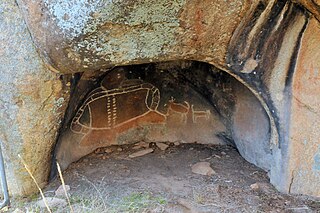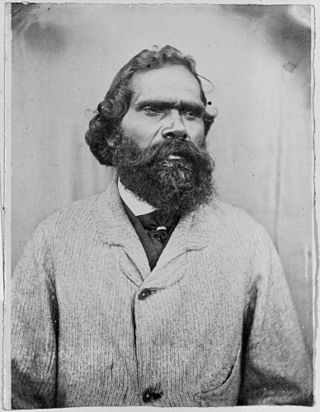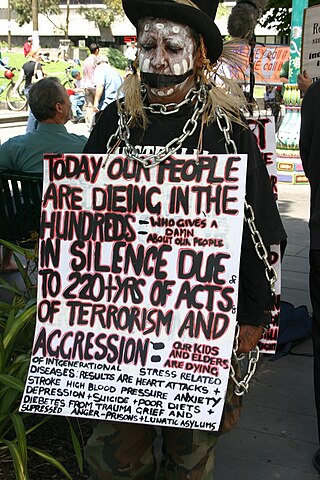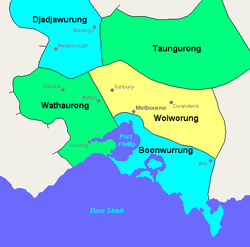History
The Taungurung people used the King and Howqua River valleys as a major route for trade or war between tribes. The Howqua River valley contains a number of archaeological sites of significance including at least two quarry sites for greenstone, an exceptionally hard rock used for stone axes, spears and other cutting tools which the Taungurung traded with other tribes. There are many other significant cultural both tangible and in tangible across their country.
A raiding party of up to 40 Taungurung is believed to have been killed in May–June 1839 on Dja Dja Wurrung territory at the Campaspe Plains massacre.
In February 1859 some Wurundjeri elders, led by Simon Wonga (aged 35) and brother Tommy Munnering (aged 24) petitioned Protector William Thomas to secure land on behalf of the Taungurung clans for the Kulin at the junction of the Acheron and Goulburn rivers in Taungurung territory. Initial representations to the Victorian Government were positive, however the intervention of the most powerful squatter in Victoria, Hugh Glass, resulted in their removal to a colder site, Mohican Station, which was not suitable for agricultural land and had to be abandoned.
In March 1863 after three years of upheaval, the surviving leaders, among them Simon Wonga and William Barak, led forty Wurundjeri, Taungurung (Goulburn River) and Boonwurrung people over the Black Spur and squatted on a traditional camping site on Badger Creek near Healesville and requested ownership of the site. This became Coranderrk Station.
The Taungurung Clans Aboriginal Corporation was registered as a Registered Aboriginal Party by the Victorian Aboriginal Heritage Council on 16 July 2009. [8]

Bunjil, also spelt Bundjil, is a creator deity, culture hero and ancestral being, often depicted as a wedge-tailed eagle in Australian Aboriginal mythology of some of the Aboriginal peoples of Victoria.

The Wurundjeripeople are an Australian Aboriginal people of the Woiwurrung language group, in the Kulin nation. They are the traditional owners of the Yarra River Valley, covering much of the present location of Melbourne. They continue to live in this area and throughout Australia. They were called the Yarra tribe by early European colonists.

The Kulin nation was an alliance of five Aboriginal nations in south-central Victoria, Australia. Their collective territory extended around Port Phillip and Western Port, up into the Great Dividing Range and the Loddon and Goulburn River valleys.

William Barak, named Beruk by his parents,, the "last chief of the Yarra Yarra tribe", was the last traditional ngurungaeta (elder) of the Wurundjeri-willam clan, the pre-colonial inhabitants of present-day Melbourne, Australia. He became an influential spokesman for Aboriginal social justice and an important informant on Wurundjeri cultural lore.
The Boonwurrung, also spelt Bunurong or Bun wurrung, are an Aboriginal people of the Kulin nation, who are the traditional owners of the land from the Werribee River to Wilsons Promontory in the Australian state of Victoria. Their territory includes part of what is now the city and suburbs of Melbourne. They were called the Western Port or Port Philip tribe by the early settlers, and were in alliance with other tribes in the Kulin nation, having particularly strong ties to the Wurundjeri people.

Simon Wonga (1824–1874), ngurungaeta and son of Billibellary, was an elder of the Wurundjeri people, who lived in the Melbourne area of Australia before European settlement. He was resolute that his people would survive the "onslaught" of white men.
A Ngurungaeta is a Woiwurrung head man or tribal leader of clans of the Woiwurrung tribes and Taungurung Ngurai-illum Wurrung. Ngurungaeta held the same tribal standing as an Arweet of the Bunurong and Wathaurong people. The current Ngurungaeta is Murrundindi. The term became of particular importance as an identifier of senior men prepared to accept Anglo control in the latter part of the 19th century. It is unlikely that the term was used to express genuine recognition of senior members of traditional groups in the Melbourne area after the 1840s, following the death of Billibellary c. 1846.

Woiwurrung and Taungurung are Aboriginal languages of the Kulin nation of Central Victoria. Woiwurrung was spoken by the Woiwurrung and related peoples in the Yarra River basin, and Taungurung by the Taungurung people north of the Great Dividing Range in the Goulburn River Valley around Mansfield, Benalla and Heathcote. They are often portrayed as distinct languages, but they were mutually intelligible. Ngurai-illamwurrung (Ngurraiillam) may have been a clan name, a dialect, or a closely related language.

Dja Dja Wurrung, also known as the Djaara or Jajowrong people and Loddon River tribe, are an Aboriginal Australian people who are the traditional owners of lands including the watersheds of the Loddon and Avoca rivers in the Bendigo region of central Victoria, Australia. They are part of the Kulin alliance of Aboriginal Victorian peoples. There are 16 clans, which adhere to a patrilineal system. Like other Kulin peoples, there are two moieties: Bunjil the eagle and Waa the crow.
Billibellary was a song maker and influential ngurungaeta of the Wurundjeri-willam clan during the early years of European settlement of Melbourne. He was known by various names including Billi-billeri, Billibellary, Jika Jika, Jacky Jacky and Jaga Jaga. He was an astute and diplomatic leader, described as powerfully built with an influence and reputation that extended well beyond his clan.

The Wurundjeri Woi Wurrung Cultural Heritage Aboriginal Corporation, previously the Wurundjeri Tribe Land and Compensation Cultural Heritage Council, is a Registered Aboriginal Party representing the Wurundjeri people, an Aboriginal Australian people of Victoria.
Munangabum was an influential clan head of the Liarga balug and Spiritual Leader or neyerneyemeet of the Dja Dja Wurrung people in central Victoria, Australia.
The Djab Wurrung, also spelt Djabwurrung, Tjapwurrung, Tjap Wurrung, or Djapwarrung, people are Aboriginal Australians whose country is the volcanic plains of central Victoria from the Mount William Range of Gariwerd in the west to the Pyrenees range in the east encompassing the Wimmera River flowing north and the headwaters of the Hopkins River flowing south. The towns of Ararat, Stawell and Hamilton are within their territory. There were 41 Djab Wurrung clans who formed an alliance with the neighbouring Jardwadjali people through intermarriage, shared culture, trade and moiety system before colonisation. Their lands were conquered but never ceded.
The Campaspe Plains massacre in 1839 in Central Victoria, Australia was as a reprisal raid against Aboriginal resistance to the invasion and occupation of the Dja Dja Wurrung and Taungurung lands. Charles Hutton took over the Campaspe run, located near the border of Dja Dja Wurrung and Taungurung, in 1838 following sporadic confrontations.

The Kulin languages are a group of closely related languages of the Kulin people, part of the Kulinic branch of Pama–Nyungan.

Aboriginal Victorians, the Aboriginal Australians of Victoria, Australia, occupied the land for tens of thousands of years prior to European settlement. Aboriginal people have lived a semi-nomadic existence of fishing, hunting and gathering, and farming eels in Victoria for at least 40,000 years.

The Woiwurrung, also spelt Woi-wurrung, Woi Wurrung, Woiwurrong, Woiworung, Wuywurung, are an Aboriginal Australian people of the Woiwurrung language group, in the Kulin alliance.

The Campaspe River, an inland intermittent river of the north–central catchment, part of the Murray-Darling basin, is located in the lower Riverina bioregion and Central Highlands and Wimmera regions of the Australian state of Victoria. The headwaters of the Campaspe River rise on the northern slopes of the Great Dividing Range and descend to flow north into the Murray River, Australia's longest river, near Echuca.
The Pallanganmiddang, otherwise known as the Waywurru, were an Indigenous Australian people of North-eastern Victoria, in the state of Victoria, Australia. Recent scholarship has suggested that In Norman Tindale's classic study his references to a Djilamatang tribe and their language arguably refer in good part to the Pallanganmiddang










